Rank a new affiliate site easily and fast in Google is a thing of the past.
It used to be that you'd write a 500-word "guide" and it'd rank immediately on the first page of Google, and it'd rule the SERPS by the end of week. It was a great way to rank a new affiliate site fast.
Well, no more!

Today, 3 million blog posts get published every day and they are more than 2 billion websites online; and with that much content to choose from Google has become a spoiled brat and it's taking it's sweet time to rank you.
Time we webmasters don't have to spare.
By reading this post, you will learn how to build out a brand new affiliate site so it starts making you money as quickly as possible
Sounds interesting?
Good!
Keep reading!
One year divided into four- building a profitable site takes planning
Note: all that you're about to read supposes you've already chosen a niche you're passionate about. Passion is crucial to success but the niche also has to be profitable to be worth your while. If you don't have a niche, then I invite you to stop reading this article and choose one right now, and then come back to finish reading. Here are some guides to help you:Now, my one-year plan for growth is a divided in 4 quarters. Each 3-months period is going to be focused (or NOT focused) on certain aspects of building an online business.
#1- Month 1-3: New kid on the block (who you are what you're about)
In the first 3 months of your site's existence you need content, simple as that. You need lots and lots of keyword-targeted content that also has the best On-page SEO tactics applied to it
So that's actually a two step process, broken down below.
a) Keyword selection for ranking a new affiliate site
New sites need only focus on long tail keywords. These are phrases that have 5, 6,7,8 words in them.
Being that long they have smaller number of people searching for them, but also much, MUCH less competition.
In fact, most have no competition and the sites that rank do so because Google has nothing better to show, and they have to show something.
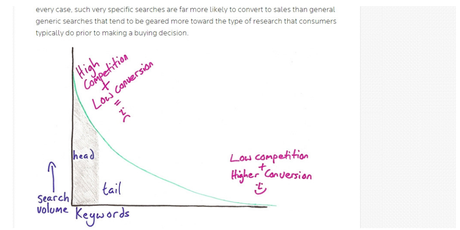
image source https://www.wordtracker.com/academy/keyword-research/guides/long-tail-keywords
So no competition, but highly lucrative because these long tails are searched for by people who know exactly what they want and why they want it, and are ready to pay for it.
So they itch to buy and now it's only a small matter of making sure they buy from you.
How to find long tail keywords that a new affiliate site can rank for?
There are so many ways to find lucrative keywords. But probably the easiest and most basic one is to do the Alphabet Soup Technique.
What is it?
That's you entering a keyword in Google Search and then going through the alphabet to see what Google suggests to you.
Something like this for example:
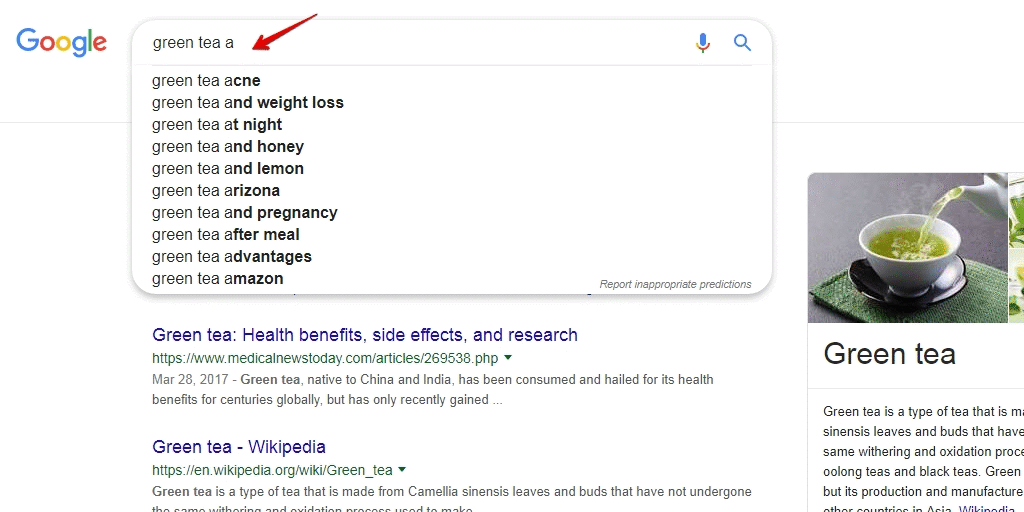
This method is rudimentary, but it works because Google will only show you popular keywords; however, you're also handicapped because you don't know the keyword's exact search volume, and more importantly- competition
So instead, I suggest you use a tool.
Personally, I use Jaaxy for all my keyword research . However, it's a premium tool so I'd like to show you a freemium alternative, KWFinder.
This tool has a premium upgrade, but the free version one does the job superbly.
So go and sign up.
Next enter a keyword ("green tea") see what it comes up with
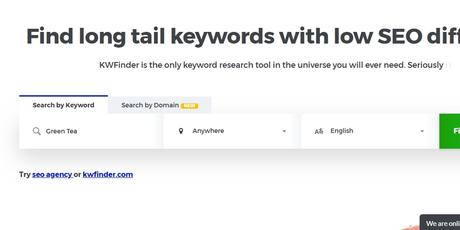
Look for metrics like search volume and keyword difficulty.
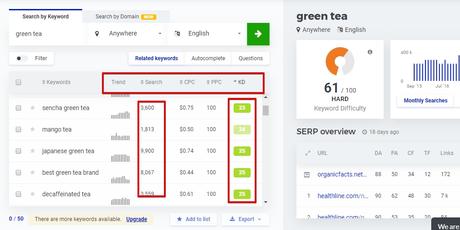
Let's pick one, (for example "Japanese green tea"), and now I will show you how to SEO an article so it ranks highly in Google right off the bat.
b) This is how to make an article extremely relevant to the query
Here's the thing:
One meaty article can rank for thousands of keywords, based on authority alone, but new site has exactly zero authority to its name so it has to rank by relevancy alone.
Relevancy is like you saying "hey Google I want to be ranked for THIS"
Now let's make it happen for you, with this step-by-step mini guide.
Note: these tips are based on Lisa's awesome guide on Simple SEO that works. Make sure you pay it a visit because it's totally worth it.Tip 1- SEO title
SEO title must contain the keyword in full. It is the most important on-page SEO element and must contain an exact match keyword.
Once your site gains a bit in strength, you won't need to be so strict with this rule, though it'll always help.
In our case, it'll be:
One meaty article can rank for thousands of keywords, based on authority alone, but new site has exactly zero authority to its name so it has to rank by relevancy alone. #SEOtips via @NikolaRoza Click To Tweet"Japanese Green Tea, Everything You must Know, and More (Guide)"
Tip 2- Keyword in URL
URL also should have an exact match keyword. This can quickly become unseemly with these long tail keywords, but no matter. It won't hurt your rankings and keyword in url sends nice relevancy signals to Google.
Tip 3- Write a meta description
There's plenty advice online that you don't need to write meta descriptions because Google don't always use it. While that's sort of true, Google-bot can still read it in the code. Which is exactly what you want as it is an easy relevancy signal to Google.
So include your exact match keyword in the meta description.
Like this:
Tip 4- Include your keyword in H1 tag (headline)
Make your headline compelling so people want to read but also include an exact match keyword if possible.
If not make it a variant of your main keyword. It's OK if it's a bit different, as long as relevancy is maintained.
Tip 5- Keyword rich "smaller" heading tags (h1, h2, h3, h4)
"Japanese green tea is one of the healthiest types of teas you can drink. Period. Learn exactly why in this evergreen guide".At least one heading tags other than H1 should contain your target keyword.
And other sub-headers can have different and related keywords.
Tip 6- image SEO is crucial
Not just for Google Images, but because image filenames and image alt attributes send further relevancy signals to Google about your' page's topic.
Image SEO is an easy SEO win, because, since it's s basic, most "clever" webmasters don't do it, because they think it's worthless.
Well, prove them wrong; don't be lazy:)
Note: make sure you don't stuff keywords where they don't belong. The reward is small and you're risking an overoptimisation penalty, which is obviously bad. for rankingsYou should have several images in any post you create and I recommend one of them to have your keyword as alt tag, and also keyword file name.
Here's an image SEO guide that can help you learn the ropes:
Tip 7- keyword in first 100 words
Have your target keyword in the first 100 words of the article.
Bottom line:This tells Google "yes, this post is about THIS keyword"
Here's how it's done on Lisa's Simple SEO checklist post:
Pro tip- write it in boldface. That is another very weak ranking signal for Google's algorithm, and it is also good user experience, because people will quickly realize they're on the right page.
Tip 8- keyword(s) within content
Once in the beginning, middle and near the end.
By this point, you will also have your target phrase in title, SEO title, URL, and heading tags.
That's signals a plenty for Google's algorithm.
So no keyword stuffing needed.
Tip 9- use external linking to boost the relevancy of your page
The sites you link to tell Google the topic of your page. So don't link to off-topic pages, and if you really have to, use a nofollow attribute.
Tip 10- do a TF-IDF optimization
This sounds like advanced stuff, but it's really easy
So easy in fact you won't believe your eyes.
Matt Diggity has a nifty guide you should check out
Tip 11- install a content table plugin
Content tables boost SEO by improving UX signals Google pays so much attention to,
Ux signals are:
And in some ways they're even more important than backlinks. You' wont rank if your UX sucks.
Simple.
Tip 12- build content hubs and clusters
This is a content creation model made popular by Hubspot.
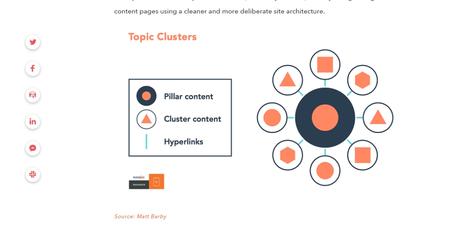
image source https://blog.hubspot.com/news-trends/topic-clusters-seo
Here's how it works:
Create a pillar page, which should be informational in nature. In our case it'll be "Ultimate Guide to Green Tea"
Then chose 10 long tail keywords and create 10 supporting articles.
Internal linking strategy:
There!
This sets Google to follow a maze of interconnected articles that all tell the same story. This site is about Green Tea. Rank it for it, NOW!
Wanna see an actual example?
On my site I've created an awesome Wealthy Affiliate review/tutorial.
It'a my 11 000-word master guide to Wealthy Affiliate, and it's also my pillar page.
- Pillar article links to 10 long tail supporting articles
- They in turn link to pillar article
- They all (11 articles) link to category page that links back to all of them
- Each article in the set of 11 links to all 10 of his brethren
And I've published 5 supporting articles (with plans for two more).
All 5 supporting articles are interlinked and they all link to pillar page; pillar page links to each of the five and finally they are all filed under same category so that category page links to all of them.
That's some wonderful SEO and logical site architecture that makes sure Google knows what I'm trying to rank for.
Make it so for your site too.
That is it.
Now your article will be hyper-relevant to the query and will have a great chance of ranking; simply because long tail keywords don't have real competition and the sites that rank do so on authority basis.
But relevance beats authority any day of the week.
#2- Months 4-6: more content and basic promotion
Ok, after the first 3 months Google has indexed your site for a tonne of keywords, and it definitely knows you exist somewhere in the universe.
But it is not enough as you're not ranking for anything. Because yours is such a young site.
What should you do now?
Now, you need to continue pumping out content, but also you need to start with some basic promotion.
Basic promotion is establishing a social media presence, and it's NOT link building (which is advanced stuff); and it is crucial to start here because now you have something to show to the world, and also it's easy and fast so as not to detract you from creating content.
For the first 6 months content is KING and promoting content is second fiddle and must not detract form content creation.
Here are some basic ways to get some brand and exposure out
These social media channels tend to work best for most folks
a) Twitter
Twitter is a gold mine for connecting with influencers. Even though a typical tweet has a shelf life of only a few minute tops, each tweet you do send gets noticed by the folks whose stuff yo're tweeting out.
For example,
here, Moss Clement tweeted one of my articles and look, I got notified of it.
Note: there are many social media channels and every niche is different. So one channel may be great for one niche but not as effective for another. Do your research so as not to waste precious time.Thank you Moss, I'll be sure to return the favor in the future.
Outdated WordPress Plugins- Are They Safe to Install on Your Website? https://t.co/jDmEmim3Fs via @NikolaRoza #wordpress #plugins #bloggingtips
- Moss Clement (@mosclement) July 3, 2019
So use Tweeter to mingle with the influencers.
Become a Twitter Ninja:
b) Pinterest
The value of using Pinterest is that pins are evergreen. One good pin could be sending you traffic for years to come.
However, the caveat is that you need nice pins to stand out. You need to learn to create them and that is the reasons I still haven't dabbled into Pinterest.
However, something is better than nothing.
Open up an account and start pining and connecting with people.
Twitter is a gold mine for connecting with influencers. Even though a typical tweet has a shelf life of only a few minute tops. #Twittertips via @NikolaRoza Click To Tweetc) Facebook
I'm not an expert in Facebook marketing and I won't pretend and dole out advice.
Note: Pinterest is a huge traffic source. I know of some people who bring upward of 100 000 people on their site through Pinterest alone.I will however say Facebook is gold for connecting with a specific type of folks- other bloggers.
So don't brush it off just because you don't understand it.So,
invest in a course to learn it- it'll be worth it long term.go out and find relevant Facebook group. Then join, make friends and genuinely contribute.
#Pinterest is a huge traffic source. I know of some people who bring upward of 100 000 people on their site through Pinterest alone. Click To TweetOver time, other bloggers, members of the group, will notice you and will want to link to you and also work with you on projects (for example, you'll be invited to guest post or do interviews...).
And lets not forget Facebook stories, which are whole another story 🙂 all together
Lisa has a guide that can clue you in:
d) Instagram
Instagram is all about the beautiful visuals, even more so that Pinterest. So it's really not that suitable for most niches.
However, if your niche is one of these:
Then Instagram can be a real traffic boon for you. It might even eclipse all other social media combined.
Remember, there are over billion active Instagram users and people process images 60 000 faster than text.
It's a powerful tool.
Instagram guide for you:
e) External linking email outreach (bonus technique)
Note: if you're in a "boring" niche not suitable for Instagram, there's still a way to use it.The number one easy promotion technique I used in my early days is linking out to influencers, then letting them know about it.
Use it for brand building, to humanize your brand and show that behind the company, there are some real people with real lives.This technique got me on the radar of many a blogger and opened many a door that would've remind closed to me for a long time.
For example, Kyle and Carson, the owners of Wealthy Affiliate Platform that I mentioned earlier, use it to show their day to day lives and their families.Here's my outreach magic working on Lisa herself
This build trust because their potential customers can relate better.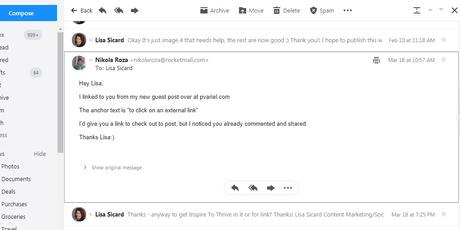
and here you are reading my post on awesome Inspire to Thrive!
Thank you, Lisa, but part of the credit should go to me, you agree:)
Months 7-9- Heavy promotion, limited content creation, up
Ok, now you have a tonne of content on your site. It's time to slow down with content creation and ramp up content promotion
And I'm not talking about basic stuff like Twitter, Facebook...
Those promotion channels are decent, but they won't move the needle the way you want it.
I'm talking about heavy promotion, i.e., building links to your site and content.
Now, link building, It's a vast field and there are a tonne of techniques you can try.
I won't talk about it here, as there's a tonne more to cover. But I wrote about linking out on Moss Clement's blog, if you want to check it out.Here I want to give you a few that are easy and beginner-friendly; and produce powerful white hat links.
a) Guest posts
Guest posting is when you write an article for another webmaster, and they post it on their site, with the article hosing a link, or several links to your site. This method really can help ranking a new affiliate site for you.
It is probably the easiest way to start getting powerful links, because it involves very little arm twisting.
In fact, you're exchanging value with other webmasters. You give them great content; and they "vouch" for you by linking to you.
You both win.
How to find guest posting opportunities?
The best way is to type:
This will open up a bunch of possibilities. for you.
Then you just need to gather these sites in a nifty little spreadsheet.
When a website advertise they accept guest posts, that means it takes very little to convince them.
However, that doesn't means you should just send them an email right away.
Instead, I recommend you spend some time to get on their radar.
- "niche" + guest post
- and "your niche" + contribute.
Share their stuff on Twitter, comment on their posts, link to them and let them know about it. Use all basic promotion techniques I mentioned earlier.
And THEN send them a pitch, which in my experience has a 100% success rate.
Neat, no?
Pro tipsInterviews are link builders dream come true.
Well almost. It is still work but since the article is about you, you get a chance to promote yourself in a logical and non-obtrusive manner.
For example, this interview I did with Nirvana Guha yielded 4 links to my site.
And none of those is shoehorned in. No, they all fit naturally as part of the narrative of my interview.
Those were some easy links for an hour' work.
b) Interviews
When you browse the web and read other blogs from your niche, see if they have "interview" section. if they do, simply bookmark their page in Chrome and then go and build a connection with that bloggers, the same you would if you wanted to ask them for a guest post opportunity.
And after you've built some kind of rapport with them, then you can ask for a chance to be interviewed.
c) Link Roundups
Link roundups are a type of posts when a blogger asks his fellow bloggers to contribute to his or her post and in return, they will give a link.
Its a very common practice and in every niche under the sun roundups are a plentiful.
The best way to find them is to use Advanced Twitter search
So within Twitter dashboard, go "advanced search"
How to find interview opportunities?Then set it up as per your search requirements.
How about an example of a massive roundup?
Here's one Enstine Muki did a while back about finding best hosting for bloggers and webmasters.
And my invitation I got from him came along.
And I know Lisa got one because I saw her reply.
d) Testimonials and contributors pages
All bloggers, but especially freelance writers like to boast of the awesome work they did and still do. And what better way to do that than to have a someone else tell how awesome they are?
For example, Simon Zaku is a freelance writer and here's his testimonial page full with praise for his work.
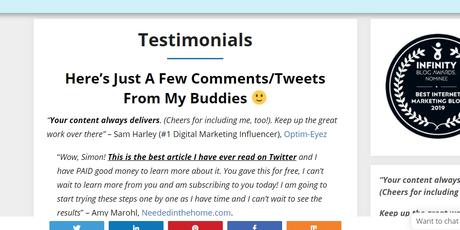
And Vishawajeet Kumar also has a testimonial page, even though he's not a freelance writer. However, Vishwajeet is an expert blogger, and he knows that when his tribe sees that other famous bloggers praise him, they will trust him and his advice more.
e) Contributor pages
Then there are contributor pages which are very similar to those that host testimonials.
Sometimes, when you guest post on a website, that person will have a " site contributors" page.
If you've contributed several times, you can then ask to be included there.
It's a free link and exposure for you.
Here me on Lisa's contributor page here:
Wanna know a secret?
These links are super powerful.
Why?
Because, and I'll use Lisa's contributor page as an example, her page is in the menu. And her menu is ever present across her site.
That means that every other post and page links to the contributor page.
And look here site has 805 pages indeed in Google.
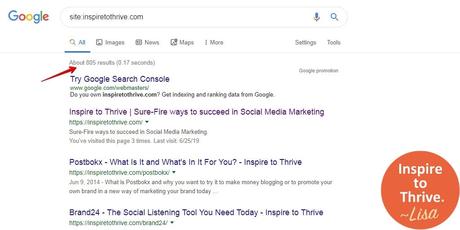
That means her site has at least 805 internal links pointing to that page.
And each internal link sends a bit of authority to that page.
I tell you, I believe links on that page are at least 10x more powerful than links in normal blog posts.
So, not all links are created equal and if you can get one of these bad boys for your affiliate site, and you will start to see the pot at the end of the rainbow.
🙂
These were some easy link building tactics you can start doing today,even if you've never built a single link in your life.
Months 10-12-Keep promoting and optimize site architecture for maximum rankings
As the subheading says, tis' time to double, triple, quadruple down on content promotion.
Forget about creating new content because you should already have between 50- 80 articles now.
Plenty of content to work with!
Now you need to focus on getting new links, because new links bring new link juice which raises your whole site in the SERPS.
And you also need to focus on skewing your site's architecture so more link juice flows to your most important pages, typically those you want to rank because you know they will bring you lots of affiliate sales.
Here's how to "hack" site architecture (advantage-YOU)
First, you want to make sure that each post on your site gets ample Page Rank. You do this trough smart internal linking, but also through making sure your site architecture is flat so none of the articles is more than 3 clicks from the homepage.
(That is because with each click around 15% of PR dissipates)
Here's an awesome guide you should read:
Second, you want to skew your site architect towards sending the most PR to your money pages.
Here's s how (3 tips).
#1- Keep your money pages on the first page or your blog roll (or on your homepage).
Because homepage is almost always the strongest of the bunch.
For example on my site, my Wealthy Affiliate Review is my featured post so it's the first link you can see.
And you also need to focus on skewing your site's architecture so more link juice flows to your most important pages. #SEOtips Click To TweetThis is super useful because the first content-body link is the most important and most PR flows there.
#2- Each "normal" post post should link to all your money pages.
This is internal linking 101. But make it intentional on your part. Actually check whether all posts link to your reviews.
#3- Your reviews should all be interlinked.
So each money page will link to all others and to no other post on the site.
#4- Your money pages need to belong under the same category.
That way they will all link to that category which of course will link to them. And your reviews are all interlinked, remember?
That creates a wonderful circle of relevancy that also eases authority spread.
What about anchor text?
Since this is internal linking we're talking about, you pretty much have free reign as per keyword usage.
I suggest you use exact and partial match anchors, mixed in with occasional naked link.
That will get you best results while keeping you safe.
Bonus- Months 13 and beyond: steady growth through balanced content creation and promotion
Ok, here we go. The year is up and your site has finally matured. You have started ranking a new affiliate site.
If you followed the plan you should have:
Now what?
Now Google trusts your website and it's going to be much easier for you to rank.
That means you can take a balanced approach to growing your site. Not just publishing content but also not just building links. I suggest you alternate: 3 months you focus mainly on content creation and building a link here and there as opportune arises.
Then next 3 months you double down on promotion and link building.
Here' why exactly.
You can't create new content and let it rank on it's own.
Because it won't.
To rank, your posts need a certain amount of authority; and If they have little PR they won't rank, even if you get everything else right.
So your content creation rate needs to be in sync with link building. Because If you create too much content too quickly, you'll dilute link authority to the point of crippling your entire site.
- lot's of content,
- decent site authority,
- steady Google traffic
- quite a few sales.
I know that's all SEO-ese, but here's an illustration, followed by an example.
If you build 100 links to your site and you have 50 indexed pages in Google, then each page gets the equivalent link juice of 2 links.
But then, if you publish 50 more pages and you don't build a single link then you'll end up with 100 pages and 100 links. That is just one link per page.
See the problem?
In other words, and I know this will somewhat shock you:
It is better to have 50 posts and 100 links, than 100 posts and 100 links.
And it is even better to have just 10 long form, meaty posts and 100 links because then each page will inherit link juice equivalent of 10 links.
That's lot of PR flowing to those pages and quite possibly enough to see some rankings (this depend on the niche you're in- some niches are easier)
And don't forget that any post on your site can rank for hundreds, sometimes 1000's of keywords.
So huge traffic can come from small number of pages.
For example, my site has 30 indexed pages in total.
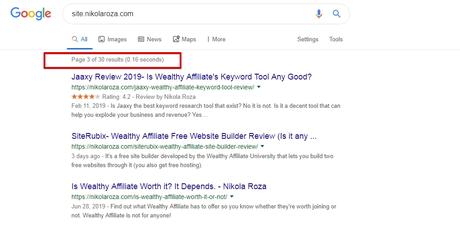
I purposely kept it small as an SEO experiment and now I have dozens of keywords hovering on page 2 and hundreds on pages 3 and 4.
And my site is really young.
it's only 18 months old and I haven't touched it in the first 9 months.
I know this strategy works but I also know that I will have to publish more content very soon as I sort off neglected my own advice and published very little while building links like crazy.
My site has 11 post but it'd be awesome if it had 24...
Conclusion- Affiliates sites: now you know how to make them profitable, FAST!
Here's the thing:
Ranking a new affiliate site nowadays is a work of art.
You can't win with content alone; there's too much competition online.
You can't win with links alone. Too little content and you won't be relevant for anything and authority won't matter much.
And,
You can't win with enough, but poor content, and artificial, fake popularity link building.
It's a disaster waiting to happen.
No, to win you need to strike a balance of great, useful content and a solid authority foundation.
You can get that by:
The problem is that it takes a long time to work, and for a large period of that slog-fest, it really looks like nothing's working and like you're just throwing spaghetti on the wall, and nothing's sticking.
But, endure and it will start to stick and you will find yourself in an enviable position. Traffic, sales, money and most people behind you. It will help you with ranking a new affiliate site
After that it'll be a breeze to keep going because you will have tasted success. Then you will have a proven method of generating the spoils of online visibility and ranking a new affiliate site.
But enough with convincing you.
You read through the entirety of this post to the end,
so you've got this down.
Now get to work; but before that,
leave me a comment below.
Thank you:)
- targeting long tail keywords,
- by building out initial authority
- and by having a bit of patience so your site naturally starts to rank and pick up links automatically

